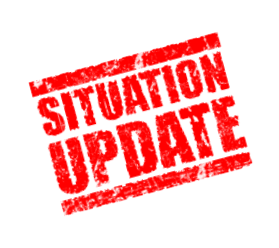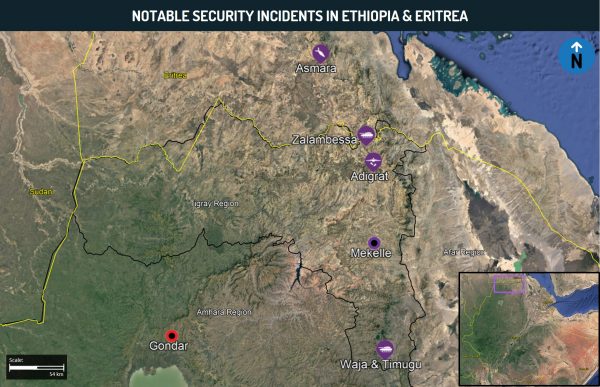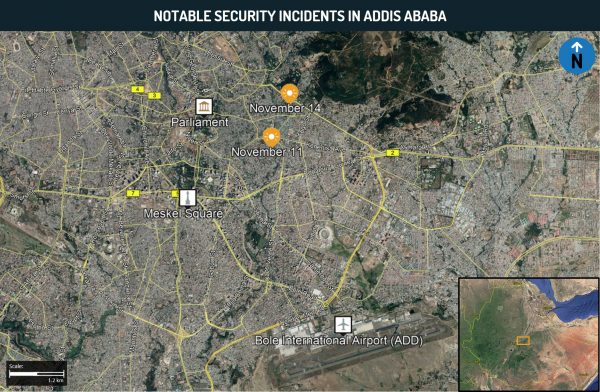15
Nov 2020
14:13 UTC
Ethiopia & Eritrea SITUATION UPDATE: TPLF claims responsibility for rocket attack on Asmara on November 14, while second grenade explosion reported in Addis Ababa
Executive Summary
- The Tigray People’s Liberation Front (TPLF) claimed responsibility for firing rockets that struck Asmara, Eritrea during the late hours of November 14. This is a notable escalation and effort to internationalize the conflict, potentially to draw Eritrea into the fighting and galvanize Ethiopians to support the TPLF against a historical enemy.
- The TPLF’s overall use of rocket attacks against Eritrea as well as Amhara Region the day before suggest an increasingly desperate move as the federal military continues its military advance into eastern and southern Tigray.
- The Addis Ababa police confirmed a grenade explosion, the second incident within days, and accused the TPLF of involvement. This is possible given the rarity of any related incidents and it is possible that similar small-scale explosions will be reported in the coming weeks.
Please be advised
- Reports indicate that at least three rockets struck Asmara, Eritrea during the late hours of November 14. The Eritrean government was cited as claiming that while rockets had been fired at Asmara, none of them hit the city. Sources suggest that the rockets landed near the airport but it is not confirmed that they struck the airport. Unconfirmed sources allege that a residential complex was hit.
- Sources cited Tigray People’s Liberation Front (TPLF) leader Debretsion Gebremichael on November 15 as confirming that they fired on Asmara. Debretsion further alleged that the TPLF has been clashing with Eritrean troops in recent days, making Asmara a legitimate target.
- In a separate interview, Debretsion claimed to have additional missiles and, when asked if he would target Addis Ababa, he demurred and stated that the missiles are also long-range.
- TPLF spokesperson Getachew Reda confirmed in an interview on November 14 that they were responsible for the rocket attacks on Bahir Dar and Gondar the previous day and threatened to strike Asmara and Massawa over the coming days.
- Reports citing the Addis Ababa police indicate that a grenade detonated in Addis Ababa’s Yeka sub-city during the afternoon of November 14, resulting in five children injured. The police reportedly stated that the grenade was “abandoned” but blamed the TPLF for “deliberately” abandoning weapons in public places.
- The Ethiopian government claimed on November 14 to have taken control of Waja and Timuga in southeastern Tigray Region.
- Unconfirmed reports indicate that the Ethiopian air force conducted airstrikes in the vicinity of Adigrat. Separate unconfirmed reports indicate that airstrikes as well as ground clashes have been reported in the vicinity of Zalambessa, along the Eritrean border.
Assessments & Forecast
- The TPLF attack on Asmara is a highly notable escalation of the conflict as the first confirmed developments inside Eritrea since the conflict began and particularly the targeting of the capital. It immediately followed the TPLF’s threats to do so earlier on November 14 while confirming their involvement in the bombing of Bahir Dar and Gondar. This heightens the potential of the internationalization of the conflict and direct Eritrean involvement. The TPLF has consistently accused Eritrea of participating in ground fighting along the border, though this has never been confirmed. The rocket attacks may be an effort to draw in public Eritrean involvement for the purpose of using it to galvanize not only Tigrayan support but broader Ethiopian support against Ethiopia’s historical enemy.
- With that said, Eritrean military engagement would likely be highly detrimental to TPLF forces along the border given the relatively steady advancement of the Ethiopian offensive that has increasingly boxed in TPLF forces in eastern Tigray. This deliberate strategy on the federal government’s part continues to be seen in its northward push in the Raya zone, where the government claimed to seize control of two towns south of Alamata, as well as new airstrikes and alleged clashes near Adigrat and Zalambessa in northeastern Tigray. This likely portends increased military activity near the Afar Region border as the TPLF may perceive it as slightly less hostile than the Amhara Region border, given the participation of Amhara forces in the conflict thus far.
- However, the TPLF appears to continue to be on its back foot and this increasingly desperate position may have motivated the rocket attacks both toward Amhara and Eritrea. The geographical expanse covered by both of these attacks, with Bahir Dar in particular at least 220 km from the Amhara-Tigray border, suggests the TPLF possesses rockets or missiles with significant range. This presents a continual threat to Asmara and Massawa in Eritrea, as well as major cities in Amhara, including Gondar, Bahir Dar, Lalibela, Dessie, and Debre Markos, and parts of northern Afar Region. Debretsion’s refusal to fully comment on whether the TPLF would be willing to strike Addis Ababa is notable. Given that the TPLF arsenal is that of Ethiopia’s, the federal government would be aware of whether the TPLF’s weapons have the necessary range to reach the capital. In any case, the use of the rockets comes as the TPLF is largely losing ground in the conventional conflict with the federal government and thus further attacks are possible.
- Meanwhile, the grenade explosion reported in Addis Ababa’s Yeka sub-city on November 14 is highly notable as the second grenade incident within days. The police had likewise described the grenade in the November 11 incident as “abandoned”, though it is a new development that they have accused the TPLF of involvement. Such an accusation is somewhat plausible in that unexploded ordnance is not a common concern in Addis Ababa. However, given the government’s interest in minimizing the public impact of news on events in the capital, the exact nature of the incidents remain unclear. This does overall align with previous small-scale security incidents in Addis Ababa and other parts of the country by opposition forces, and it is possible that the TPLF or other anti-government elements are involved. Nonetheless, further incidents involving grenades or other small explosive devices may recur in Addis Ababa in the coming weeks.
Recommendations
- Those operating or residing in Ethiopia over the coming days are advised to avoid all travel to Tigray Region as well as the Tigray-Amhara border region due to the ongoing conflict.
- Those in Tigray Region are advised to minimize all movement. Consider contingency and evacuation plans when possible.
COUNTRY RISK LEVEL
High
AFFECTED AREA
Asmara, Eritrea; Addis Ababa & Tigray Region, Ethiopia
INCIDENT RISK LEVEL
Extreme
STRENGTH OF SOURCE
Credible
Executive Summary
- The Tigray People’s Liberation Front (TPLF) claimed responsibility for firing rockets that struck Asmara, Eritrea during the late hours of November 14. This is a notable escalation and effort to internationalize the conflict, potentially to draw Eritrea into the fighting and galvanize Ethiopians to support the TPLF against a historical enemy.
- The TPLF’s overall use of rocket attacks against Eritrea as well as Amhara Region the day before suggest an increasingly desperate move as the federal military continues its military advance into eastern and southern Tigray.
- The Addis Ababa police confirmed a grenade explosion, the second incident within days, and accused the TPLF of involvement. This is possible given the rarity of any related incidents and it is possible that similar small-scale explosions will be reported in the coming weeks.
Please be advised
- Reports indicate that at least three rockets struck Asmara, Eritrea during the late hours of November 14. The Eritrean government was cited as claiming that while rockets had been fired at Asmara, none of them hit the city. Sources suggest that the rockets landed near the airport but it is not confirmed that they struck the airport. Unconfirmed sources allege that a residential complex was hit.
- Sources cited Tigray People’s Liberation Front (TPLF) leader Debretsion Gebremichael on November 15 as confirming that they fired on Asmara. Debretsion further alleged that the TPLF has been clashing with Eritrean troops in recent days, making Asmara a legitimate target.
- In a separate interview, Debretsion claimed to have additional missiles and, when asked if he would target Addis Ababa, he demurred and stated that the missiles are also long-range.
- TPLF spokesperson Getachew Reda confirmed in an interview on November 14 that they were responsible for the rocket attacks on Bahir Dar and Gondar the previous day and threatened to strike Asmara and Massawa over the coming days.
- Reports citing the Addis Ababa police indicate that a grenade detonated in Addis Ababa’s Yeka sub-city during the afternoon of November 14, resulting in five children injured. The police reportedly stated that the grenade was “abandoned” but blamed the TPLF for “deliberately” abandoning weapons in public places.
- The Ethiopian government claimed on November 14 to have taken control of Waja and Timuga in southeastern Tigray Region.
- Unconfirmed reports indicate that the Ethiopian air force conducted airstrikes in the vicinity of Adigrat. Separate unconfirmed reports indicate that airstrikes as well as ground clashes have been reported in the vicinity of Zalambessa, along the Eritrean border.
Assessments & Forecast
- The TPLF attack on Asmara is a highly notable escalation of the conflict as the first confirmed developments inside Eritrea since the conflict began and particularly the targeting of the capital. It immediately followed the TPLF’s threats to do so earlier on November 14 while confirming their involvement in the bombing of Bahir Dar and Gondar. This heightens the potential of the internationalization of the conflict and direct Eritrean involvement. The TPLF has consistently accused Eritrea of participating in ground fighting along the border, though this has never been confirmed. The rocket attacks may be an effort to draw in public Eritrean involvement for the purpose of using it to galvanize not only Tigrayan support but broader Ethiopian support against Ethiopia’s historical enemy.
- With that said, Eritrean military engagement would likely be highly detrimental to TPLF forces along the border given the relatively steady advancement of the Ethiopian offensive that has increasingly boxed in TPLF forces in eastern Tigray. This deliberate strategy on the federal government’s part continues to be seen in its northward push in the Raya zone, where the government claimed to seize control of two towns south of Alamata, as well as new airstrikes and alleged clashes near Adigrat and Zalambessa in northeastern Tigray. This likely portends increased military activity near the Afar Region border as the TPLF may perceive it as slightly less hostile than the Amhara Region border, given the participation of Amhara forces in the conflict thus far.
- However, the TPLF appears to continue to be on its back foot and this increasingly desperate position may have motivated the rocket attacks both toward Amhara and Eritrea. The geographical expanse covered by both of these attacks, with Bahir Dar in particular at least 220 km from the Amhara-Tigray border, suggests the TPLF possesses rockets or missiles with significant range. This presents a continual threat to Asmara and Massawa in Eritrea, as well as major cities in Amhara, including Gondar, Bahir Dar, Lalibela, Dessie, and Debre Markos, and parts of northern Afar Region. Debretsion’s refusal to fully comment on whether the TPLF would be willing to strike Addis Ababa is notable. Given that the TPLF arsenal is that of Ethiopia’s, the federal government would be aware of whether the TPLF’s weapons have the necessary range to reach the capital. In any case, the use of the rockets comes as the TPLF is largely losing ground in the conventional conflict with the federal government and thus further attacks are possible.
- Meanwhile, the grenade explosion reported in Addis Ababa’s Yeka sub-city on November 14 is highly notable as the second grenade incident within days. The police had likewise described the grenade in the November 11 incident as “abandoned”, though it is a new development that they have accused the TPLF of involvement. Such an accusation is somewhat plausible in that unexploded ordnance is not a common concern in Addis Ababa. However, given the government’s interest in minimizing the public impact of news on events in the capital, the exact nature of the incidents remain unclear. This does overall align with previous small-scale security incidents in Addis Ababa and other parts of the country by opposition forces, and it is possible that the TPLF or other anti-government elements are involved. Nonetheless, further incidents involving grenades or other small explosive devices may recur in Addis Ababa in the coming weeks.
Recommendations
- Those operating or residing in Ethiopia over the coming days are advised to avoid all travel to Tigray Region as well as the Tigray-Amhara border region due to the ongoing conflict.
- Those in Tigray Region are advised to minimize all movement. Consider contingency and evacuation plans when possible.



